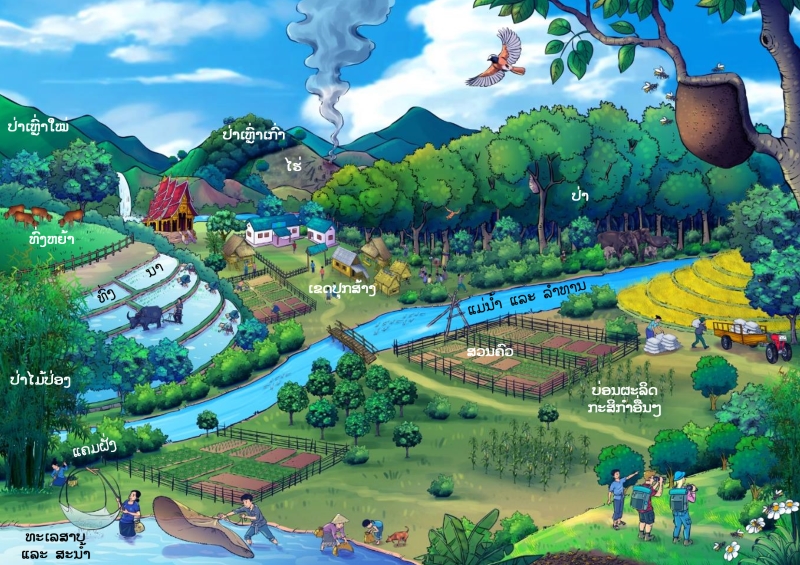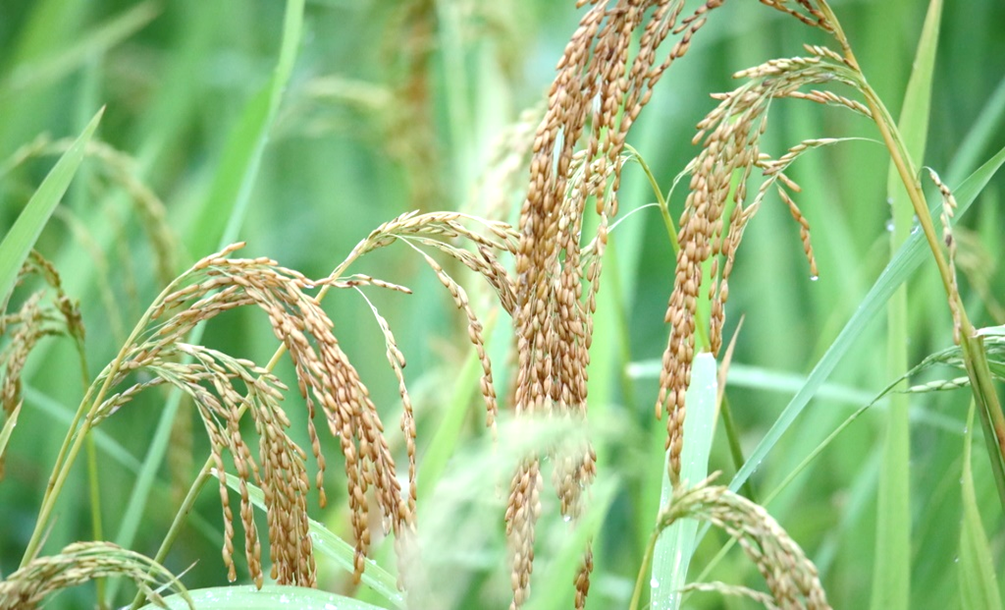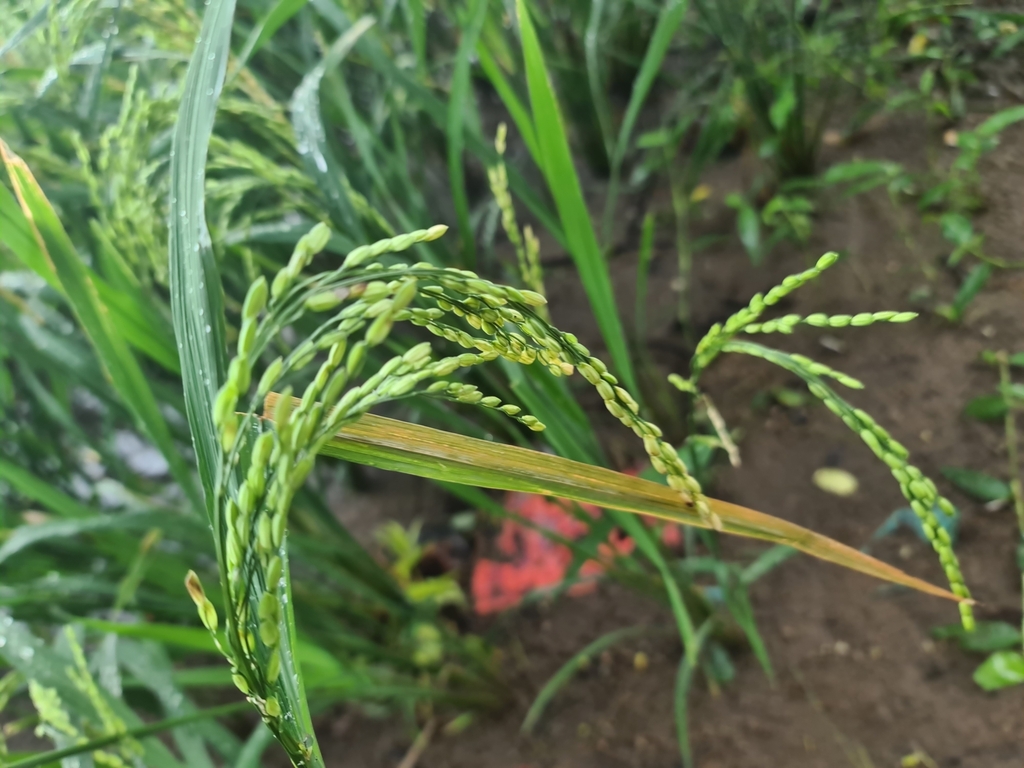ເລກລຳດັບທີ: 142
ລະດັບການຮວບຮວມຂໍ້ມູນ: ຂໍ້ມູນພື້ນຖານ
ປັບປູງຄັ້ງລ່າສຸດ: N/A
ເຂົ້າໄກ່ນ້ອຍລາຍ
Wart Little Chicken Rice
Oryza sativa L. subsp. japonica Shig.Kato
ພືດ
ພືດລົ້ມລຸກ
ຫຍ້າ ແລະ ທັນຍາພືດ
×
ຊື່ທ້ອງຖີ່ນ:
ຊື່ພ້ອງ
:
ຊື່ສະກຸນ:
Poaceae
ຊະນິດໃກ້ຄຽງ:
ບັນຍາຍລັກສະນະທາງພືດສາດ:
ເຂົ້າໄກ່ນ້ອຍ ເປັນເຂົ້າໜຽວພື້ນເມືອງລາວ ທີ່ມີເອກະລັກສະເພາະທາງດ້ານຮູບຮ່າງ ແລະຂະໜາດທີ່ໂດດເດັ່ນ. ເມັດພືດມີຂະໜາດນ້ອຍ ແລະ ກົມ, ມີເສັ້ນຜ່າສູນກາງລະຫວ່າງ 1.85-2.01 ມມ, ຄວາມຍາວ 6.64-7.14 ມມ, ກວ້າງ 3.45-3.77 ມ.ມ ແລະ ໜາ 2.14-2.40 ມ. ແນວພັນເຂົ້ານີ້ສະແດງໃຫ້ເຫັນຄວາມຫຼາກຫຼາຍຂອງແກ່ນ, ຮູບຮ່າງ, ແລະສີ, ເຖິງແມ່ນວ່າຢູ່ໃນແນວພັນດຽວ ຫຼື ຮວງ. ການປ່ຽນແປງເຫຼົ່ານີ້ສາມາດໄດ້ຮັບອິດທິພົນຈາກປັດໃຈສິ່ງແວດລ້ອມ, ໂດຍສະເພາະລະດັບຄວາມສູງຈາກໜ້ານ້ຳທະເລ. ເຂົ້າໄກ່ນ້ອຍທີ່ມີຄຸນນະພາບດີທີ່ສຸດແມ່ນປູກຢູ່ລະດັບຄວາມສູງລະຫວ່າງ 700-1,100 ແມັດ.
ລັກສະນະພິເສດອັນໜຶ່ງຂອງເຂົ້າໄກ່ນ້ອຍແມ່ນສີ ແລະ ຮູບຮ່າງຂອງເປືອກຂອງມັນ, ເຊິ່ງແຕກຕ່າງກັນ ແລະ ສາມາດຈຳແນກໄດ້ຢ່າງງ່າຍດາຍ. ເຖິງວ່າຈະມີຄວາມແຕກຕ່າງເຫຼົ່ານີ້, ເຂົ້າໄກ່ນ້ອຍທຸກປະເພດມີຮູບຮ່າງກົມ. ເມື່ອໜຶ້ງ, ເຂົ້າມີຄວາມຫອມ, ລົດຊາດຫວານ ແລະ ມີຄວາມອ່ອນນຸ່ມເປັນເອກະລັກສະເພາະທີ່ສາມາດເຮັດໃຫ້ມັນແຕກຕ່າງຈາກເຂົ້າຊະນິດອື່ນ[4]
ລັກສະນະພິເສດອັນໜຶ່ງຂອງເຂົ້າໄກ່ນ້ອຍແມ່ນສີ ແລະ ຮູບຮ່າງຂອງເປືອກຂອງມັນ, ເຊິ່ງແຕກຕ່າງກັນ ແລະ ສາມາດຈຳແນກໄດ້ຢ່າງງ່າຍດາຍ. ເຖິງວ່າຈະມີຄວາມແຕກຕ່າງເຫຼົ່ານີ້, ເຂົ້າໄກ່ນ້ອຍທຸກປະເພດມີຮູບຮ່າງກົມ. ເມື່ອໜຶ້ງ, ເຂົ້າມີຄວາມຫອມ, ລົດຊາດຫວານ ແລະ ມີຄວາມອ່ອນນຸ່ມເປັນເອກະລັກສະເພາະທີ່ສາມາດເຮັດໃຫ້ມັນແຕກຕ່າງຈາກເຂົ້າຊະນິດອື່ນ[4]
ນິເວດວິທະຍາ
ເຂດກະຈາຍພັນທົ່ວໂລກ:
Endemism in Xiengkhouang, Laos
ເຂດກະຈາຍພັນໃນລາວ
:
ເຂດພູສູງສາຍພູຫຼວງ ແລະ ເຂດພູພຽງແຂວງຊຽງຂວາງ

ເຂດກະຈາຍພັນຕາມພູມສັນຖານ
:
ທົ່ງນາ
ເຂດຜະລິດພືດຜົນເນີນສູງ
ເຂດຜະລິດພືດຜົນເນີນສູງ

ສະເພາະຖິ່ນໃນລາວ:
ສະເພາະຖິ່ນໃນລາວ
ຮຸກຮານ
:
ບໍ່ຮຸກຮານ
ສະຖານະພາບການອະນູຮັກ IUCN
:
ບໍ່ມີຄວາມສ່ຽງ
ສະຖານະພາບການອະນຸຮັກແຫ່ງຊາດລາວ
:
ບັນຊີທີ່ III: ຊະນິດພັນປະເພດທົ່ວໄປ
ການນຳໃຊ້
ປະເພດການນຳໃຊ້:
ອາຫານ
ບັນຍາຍການນຳໃຊ້:
ອາຫານ: ເຂົ້າໄກ່ນ້ອຍ ເປັນເຂົ້າໜຽວພື້ນເມືອງລາວ ທີ່ມີຮູບຮ່າງ ແລະຂະໜາດທີ່ໂດດເດັ່ນ. ມັນມີກິ່ນຫອມ, ລົດຊາດຫວານແລະຄວາມອ່ອນນຸ້ມທີ່ເປັນເອກະລັກທີ່ສາມາດເຮັດໃຫ້ມັນແຕກຕ່າງຈາກເຂົ້າປະເພດອື່ນໆ [4].
ການປູກ ການລ້ຽງ:
ຊະນິດປູກ
ລະດູການເກັບກູ້:
ມິຖຸນາ
ກໍລະກົດ
ສິງຫາ
ກັນຍາ
ຕຸລາ
ພະຈິກ
ທັນວາ
ກໍລະກົດ
ສິງຫາ
ກັນຍາ
ຕຸລາ
ພະຈິກ
ທັນວາ
ການຕະຫຼາດ ແລະ ຕ່ອງໂສ້ມູນຄ່າ:
ການຕະຫລາດ:
• ເຂົ້າໄກ່ນ້ອຍທີ່ຜະລິດ ໃນແຂວງຫົວພັນ ໄດ້ຂາຍອອກ 65%, ສ່ວນທີ່ເຫລືອແມ່ນບໍລິ ໂພກພາຍໃນຄອບຄົວຊາວກະສິກອນ.
• ມີພໍ່ຄ້າ-ແມ່ຄ້າທ້ອງຖິ່ນເປັນຈຳນວນຫລາຍທີ່ເຮັດການຊື້-ຂາຍເຂົ້າໄກ່ນ້ອຍຢູ່ພາຍ ໃນແຂວງ.
• ລາຄາຂາຍຍົກເຂົ້າໄກ່ນ້ອຍຢູ່ກັບທີ່ແມ່ນ 6,000-7,000 ກີບ/ກິໂລ, ສ່ວນລາຄາຂາຍ ຍ່ອຍແມ່ນ 8,000-10,000 ກີບ ຕໍ່ ກິໂລ. [7]
• ເຂົ້າໄກ່ນ້ອຍທີ່ຜະລິດ ໃນແຂວງຫົວພັນ ໄດ້ຂາຍອອກ 65%, ສ່ວນທີ່ເຫລືອແມ່ນບໍລິ ໂພກພາຍໃນຄອບຄົວຊາວກະສິກອນ.
• ມີພໍ່ຄ້າ-ແມ່ຄ້າທ້ອງຖິ່ນເປັນຈຳນວນຫລາຍທີ່ເຮັດການຊື້-ຂາຍເຂົ້າໄກ່ນ້ອຍຢູ່ພາຍ ໃນແຂວງ.
• ລາຄາຂາຍຍົກເຂົ້າໄກ່ນ້ອຍຢູ່ກັບທີ່ແມ່ນ 6,000-7,000 ກີບ/ກິໂລ, ສ່ວນລາຄາຂາຍ ຍ່ອຍແມ່ນ 8,000-10,000 ກີບ ຕໍ່ ກິໂລ. [7]
ການຄຸ້ມຄອງຈັດການ
ສະພາບໂດຍລວມ: ເຂດທີ່ປູກເຂົ້າໄກ່ນ້ອຍໄດ້ດີແມ່ນຈະນອນຢູ່ໃນຂອບເຂດ ລະຫວ່າງ ເສັ້ນຂະໜານທີ 19 ແລະ 20 ອົງສາເໜືອ ແລະ ລະຫວ່າງ ເສັ້ນແວງທີ 103 ແລະ 104 ອົງ ສາ ຕາເວັນອອກ. ຊຶ່ງມີລະດັບສູງ ຈາກໜ້ານ້ຳທະເລແຕກຕ່າງກັນ ແຕ່ 663 1,220 ແມັດ. ໃນນັ້ນ ເຂົ້າໄກ່ນ້ອຍ ທີ່ເກັບ ຈາກ ແຂວງຊຽງຂວາງ ແມ່ນສູງກວ່າ 1,046 ຫາ 1,220 ແມັດ ຈາກລະດັບນ້ຳທະເລ. [6]
ອຸນຫະພູມ: ອຸນຫະພູມຈະຮ້ອນຫຼາຍຊ່ວງປັກດຳ ຫາ ຊ່ວງເຂົ້າແຕກກໍ ແລະ ຈະລຸດລົງແຕ່ຊ່ວງເຂົ້າກໍາລັງອອກດອກ ຈົນຮອດໄລຍະເກັບກ່ຽວ.[6]
ປະລິມານນ້ຳຝົນ: ປົກກະຕິ ຝົນມັກຕົກຊ່ວງ ເຂົ້າ ກໍາລັງມານ (ຕົ້ນເດືອນກັນຍາ ຫາ ກາງເດືອນຕຸລາ).
ຄວາມຊຸ່ມຂອງອາກາດ: ເລີ້ມແຕ່ຊ່ວງເຂົ້າອອກດອກ ຈະມີນໍ້າໝອກຫຼາຍຂຶ້ນເລື້ອຍໆ ຈົນຮອດໄລຍະເກັບກ່ຽວ.[6]
ປະລິມານແສງແດດ: ໃນໄລຍະປັກດໍາ ຫາ ໄລຍະ ແຕກກໍສູງສຸດ ປະລິມານແສງແດດຈະຫຼາຍ. ແຕ່ໄລຍະເຂົ້າອອກດອກ ໄປຫາໄລຍະເກັບກ່ຽວ ປະລິມານແສງແດດ ຈະລຸດລົງ ເຖິງ 40% ເນື່ອງ ຈາກມີນໍ້ຳໝອກປົກຄຸມດົນ ໃນແຕ່ລະມື້ ຫຼື ມີຝົນຝອຍເປັນໄລຍະ.[6]
ເທັກນິກການປູກ: ສໍາລັບການປູກເຂົ້າໄກ່ນ້ອຍແມ່ນຈະເລີ່ມຕົກກ້າໃນເດືອນພຶດສະພາ ປະມານ ວັນ 1-2 ເດືອນ ມິຖຸນາ ແມ່ນເລີ່ມການປັກດໍາ ຫຼັງຈາກປັກດໍາແລ້ວ ປະມານ ວັນທີ່ 16-17 ເດືອນ ຕຸລາ ແມ່ນເລີ່ມມີການເກັບກ່ຽວ. ສະຖານທີ່ ໃນການປູກຢູ່ທົ່ງພຽງທີ່ບໍ່ມີລະດັບສູງສາມາດປູກໄດ້ແຕ່ຄຸນນະພາບບໍ່ດີ (ລົດຊາດ ອ່ອນ ແລະ ຄວາມຫອມ), ລະດັບນໍ້າເຢັນ ແລະ ນໍ້າທໍາມະດາກໍ່ມີຄຸນນະພາບແຕກຕ່າງກັນ. ການປູກເຂົ້າໄກ່ນ້ອຍໃນແຕ່ລະທ້ອງຖິ່ນແມ່ນຄ້າຍຄືກັນ ໂດຍສະເພາະການຕົກກ້າບາງບ່ອນເຮັດກ້າຊໍາ, ບາງ ບ່ອນເຮັດກ້າຜົງ ແລະ ບາງບ່ອນປັກດໍາໃສ່ກ້າກີບດຽວເມື່ອອາຍຸກ້າ 15 ວັນ.[6]
ອຸນຫະພູມ: ອຸນຫະພູມຈະຮ້ອນຫຼາຍຊ່ວງປັກດຳ ຫາ ຊ່ວງເຂົ້າແຕກກໍ ແລະ ຈະລຸດລົງແຕ່ຊ່ວງເຂົ້າກໍາລັງອອກດອກ ຈົນຮອດໄລຍະເກັບກ່ຽວ.[6]
ປະລິມານນ້ຳຝົນ: ປົກກະຕິ ຝົນມັກຕົກຊ່ວງ ເຂົ້າ ກໍາລັງມານ (ຕົ້ນເດືອນກັນຍາ ຫາ ກາງເດືອນຕຸລາ).
ຄວາມຊຸ່ມຂອງອາກາດ: ເລີ້ມແຕ່ຊ່ວງເຂົ້າອອກດອກ ຈະມີນໍ້າໝອກຫຼາຍຂຶ້ນເລື້ອຍໆ ຈົນຮອດໄລຍະເກັບກ່ຽວ.[6]
ປະລິມານແສງແດດ: ໃນໄລຍະປັກດໍາ ຫາ ໄລຍະ ແຕກກໍສູງສຸດ ປະລິມານແສງແດດຈະຫຼາຍ. ແຕ່ໄລຍະເຂົ້າອອກດອກ ໄປຫາໄລຍະເກັບກ່ຽວ ປະລິມານແສງແດດ ຈະລຸດລົງ ເຖິງ 40% ເນື່ອງ ຈາກມີນໍ້ຳໝອກປົກຄຸມດົນ ໃນແຕ່ລະມື້ ຫຼື ມີຝົນຝອຍເປັນໄລຍະ.[6]
ເທັກນິກການປູກ: ສໍາລັບການປູກເຂົ້າໄກ່ນ້ອຍແມ່ນຈະເລີ່ມຕົກກ້າໃນເດືອນພຶດສະພາ ປະມານ ວັນ 1-2 ເດືອນ ມິຖຸນາ ແມ່ນເລີ່ມການປັກດໍາ ຫຼັງຈາກປັກດໍາແລ້ວ ປະມານ ວັນທີ່ 16-17 ເດືອນ ຕຸລາ ແມ່ນເລີ່ມມີການເກັບກ່ຽວ. ສະຖານທີ່ ໃນການປູກຢູ່ທົ່ງພຽງທີ່ບໍ່ມີລະດັບສູງສາມາດປູກໄດ້ແຕ່ຄຸນນະພາບບໍ່ດີ (ລົດຊາດ ອ່ອນ ແລະ ຄວາມຫອມ), ລະດັບນໍ້າເຢັນ ແລະ ນໍ້າທໍາມະດາກໍ່ມີຄຸນນະພາບແຕກຕ່າງກັນ. ການປູກເຂົ້າໄກ່ນ້ອຍໃນແຕ່ລະທ້ອງຖິ່ນແມ່ນຄ້າຍຄືກັນ ໂດຍສະເພາະການຕົກກ້າບາງບ່ອນເຮັດກ້າຊໍາ, ບາງ ບ່ອນເຮັດກ້າຜົງ ແລະ ບາງບ່ອນປັກດໍາໃສ່ກ້າກີບດຽວເມື່ອອາຍຸກ້າ 15 ວັນ.[6]
ໂພຊະນາການ
ຄຸນຄ່າທາງໂພຊະນາການ:
ແຫຼ່ງຄາໂບໄຮເດຣດທີ່ສຳຄັນ
ບັນຍາຍຄຸນຄ່າທາງໂພຊະນາການ:
N/A
| ສານອາຫານ | /100g | ໝາຍເຫດ |
|---|---|---|
| ໂປຣຕີນ | N/A | N/A |
| ຄາໂບໄຮເດຣດ | N/A | N/A |
| ໄຂມັນ | N/A | N/A |
| ວິຕາມິນ | N/A | N/A |
| ແຮ່ທາດ | N/A | N/A |
| ເສັ້ນໄຍ | N/A | N/A |
ອ້າງອິງ
ເຄດິດຮູບພາບ:
Oryza sativa subsp. [1] iNaturalist [Online]. Uploaded on 9 January 2021 by: yolanfa. Available: https://www.inaturalist.org/observations/67766690. [Accessed: 14 October 2024]
Oryza sativa subsp from close up. [2] iNaturalist [Online]. Uploaded on 2 November 2020 by: agonzalo. Available: https://www.inaturalist.org/observations/63984261. [Accessed: Accessed: 14 October 2024]
Oryza sativa subsp from afar. [3] iNaturalist [Online]. Uploaded on 6 October 2019 by: gab00229. Available: https://www.inaturalist.org/observations/33959376. [Accessed: Accessed: 14 October 2024]
Oryza sativa subsp from close up. [2] iNaturalist [Online]. Uploaded on 2 November 2020 by: agonzalo. Available: https://www.inaturalist.org/observations/63984261. [Accessed: Accessed: 14 October 2024]
Oryza sativa subsp from afar. [3] iNaturalist [Online]. Uploaded on 6 October 2019 by: gab00229. Available: https://www.inaturalist.org/observations/33959376. [Accessed: Accessed: 14 October 2024]
ອ້າງອິງ:
[4] J. VONGDALUK and K. THANAKONE, Registration Of The Origin Of Kao Kai Noy Rice In Xieng Khouang Province, Faculty of Law and Political Science Department of Business Law Academic Year 2019-2020
[5] Global Biodiversity Information Facility (GBIF),[Online]. Available: https://www.gbif.org/species/2703459. [Accessed: 14 October 2024].
[6] C. BOUNPHANOUSAY, V. BOUNPHANOUSAY, K. KANYAVONG & P. In-THAPANYA., "Khao Kay Noi (“Small Chicken Rice”) is high grain quality confined to higher altitude," The Lao Journal of Agricul-ture and Forestry, No. 20, pp. 1-107, Dec 2009.
[7] Phakhaolao [Online] “Oryza sativa subsp’’; Available: https://www.phakhaolao.la/sites/default/files/public/publications/attachments/P14_HPH_KKN_A1_02.pdf. [Accessed: 15 October 2024].
[5] Global Biodiversity Information Facility (GBIF),[Online]. Available: https://www.gbif.org/species/2703459. [Accessed: 14 October 2024].
[6] C. BOUNPHANOUSAY, V. BOUNPHANOUSAY, K. KANYAVONG & P. In-THAPANYA., "Khao Kay Noi (“Small Chicken Rice”) is high grain quality confined to higher altitude," The Lao Journal of Agricul-ture and Forestry, No. 20, pp. 1-107, Dec 2009.
[7] Phakhaolao [Online] “Oryza sativa subsp’’; Available: https://www.phakhaolao.la/sites/default/files/public/publications/attachments/P14_HPH_KKN_A1_02.pdf. [Accessed: 15 October 2024].
ຜູ້ສ້າງ Factsheet:
ຜູ້ກວດສອບ Factsheet:
,

